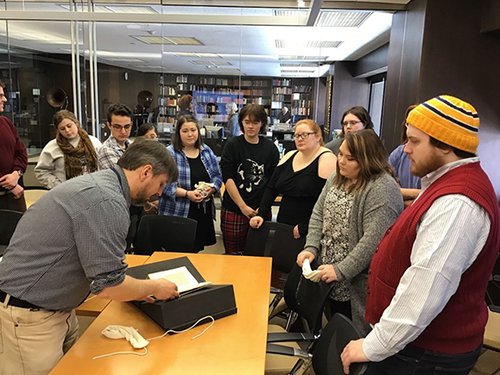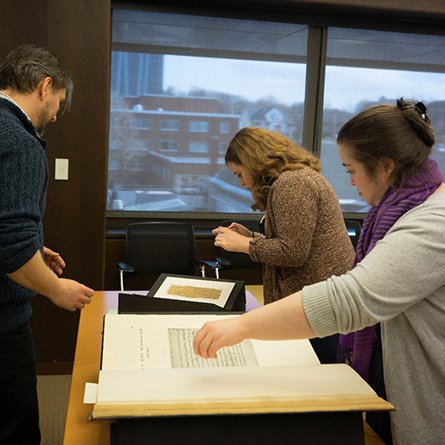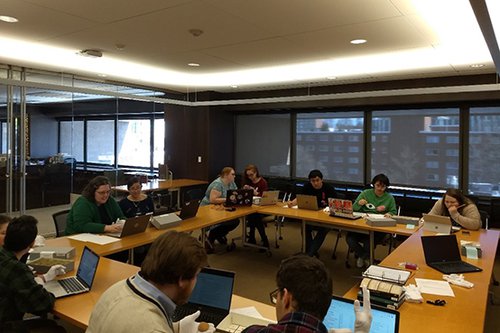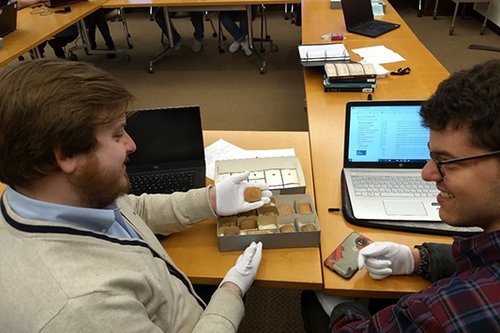From Clay Tablet to Cyber Space: A Semester Full of Library and Archives History

By Sebastian Modrow, Curator of Rare Books and Manuscripts
The history of libraries or archives could easily fill a whole sequence of courses. During the 2019 spring semester, a group of 12 Library Science students from Syracuse University’s iSchool and their instructor set out (very ambitiously!) to cover the major developments of these two types of information repositories, starting out at the geographic fringes of the Western World (the ancient Near East and ancient Egypt) and moving geographically and chronologically through Europe and North America all the way into the supposed ‘placelessness’ of cyber space. Their quest centered around studying the role and development of libraries and archives in their historical context. The course was called “The History of Libraries and Archives in the Western World.”

Modrow with students examining materials in a class session in SCRC.

Examining an original fragment of papyrus and a facsimile, side by side.
While variations of this type of course might address the history of libraries and archives individually, a joint perspective merged into one course has not yet come to my attention. Separate treatment of libraries and archives artificially disentangles a much intertwined history of these two repository types. This entanglement can still be felt today in the collection development of special collections departments, the ongoing struggle for emancipation of archival theory and practice from library management doctrine, as well as the widespread occurrence of employing trained librarians in archivist positions.
Why study library and archives history at all? An obvious benefits of the historical perspective is enabling aspiring librarians, who will engage with the ongoing discussions about the orientation of their professions, to understand the crucial role that libraries and archives play as selective information repositories in a society’s (re)construction of the collective past. Far from being the once proclaimed pristine and untainted springs of objective information, libraries and archives have come under scrutiny for their ‘curatedness’; that is, for the impact of their collection bias as it relates to the maintenance of power structures over time. In order to understand "history," it might not hurt, therefore, to step back for a moment or a semester and - instead of studying Clio's sources – to study the history of two of her most important source repositories – libraries and archives.
During the course, the participants learned that this sometimes confusing relationship goes back all the way to the beginning of textual repositories in ancient Mesopotamia. At the center of the course was a discussion on the centuries-permeating mythology surrounding the Library of Alexandria. Each century, the mythos grew and changed in service of the needs of librarians and historians of the time. For example, it strongly influenced the development of public libraries in the nineteenth century, thereby making the history of libraries and archives into a history of (often very powerful) ideas. The course also traced the relationship between information access and maintenance of power structures from the text repositories of the kings of Assur, democratic Athens, Republican and Imperial Rome, monastic libraries and early modern patrimonial archives all the way to the politics of modern archives and libraries.

The full class working in groups.

Two students examine a cuneiform tablet.
Focusing on developments in the Western World was one way to reduce the ground that needed to be covered in this course. The course met at SCRC in order to make ample use of SCRC’s holdings: from cuneiform tablets, a papyrus fragment, medieval manuscripts and early prints to digitized material online. Primary source-based learning brought these future librarians and archivists in (literal) contact with the work of their professional ancestors and allowed a first-hand experience of the physicality and thereby, the organization and preservation demands of bygone information media. When discussing, for example, the content and physical arrangement of Mesopotamian archives, students were able to study original clay tablets aided by secondary literature, archival finding aids, and related metadata from the tablets’ digital surrogates in the database of the Cuneiform Digital Library Initiative (CDLI). When discussing medieval and early modern library security, a binding bearing traces of a chain lash exemplified the practice of chaining books to shelves and desks. More recently, a card catalog drawer could help students understand the labor of librarians and researchers of the analog age.
As part of their assignments, students gave a presentation on a selected case study of either an important information repository, such as the Library of Alexandria, the Venetian Archives or the Library of Congress, or influential figure, such as Edward Edwards or Andrew Carnegie. A final research paper brought together the students' understanding of their future profession’s past. Paper topics ranged from “Aristotle’s Library: On Preservation and Information Control” to “Leibnizian Conceptions of the Ideal Library” to “Queer Archives as Agents of Change and Responses to Oppression.”
While working with rare books and archival materials, students were frequently asked to research and briefly present on pulled collection items. These group project-based in-class assignments, which involved searching for and researching collection materials online, introduced students to the structure of rare book related catalog records and archival finding aids. Engaging students with primary source research methodology gave occasion to discuss the workings of a special collections department, which ultimately proved to be the ideal setting for teaching a course on library and archives history.
